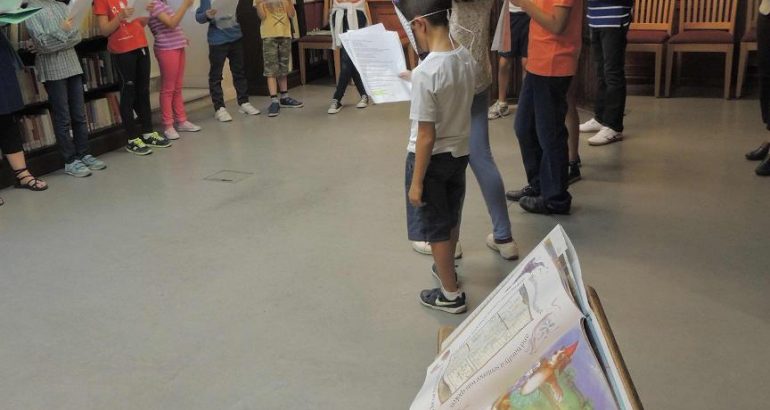
READERS THEATER: la lectura como diversión y apertura a los demás
Un curso, dos cursos, tres cursos. Tiempo suficiente como para que la actividad “Readers’ Theater” para chicos de 9 a 12 años se haya vuelto imprescindible en la agenda infantil del Instituto. El aumento gradual de público interesado y el saber hacer de quienes dinamizan la actividad han hecho que en este curso además le haya salido un hermano mayor: “Readers’ Theater for Adults”.
Las lecturas dramatizadas tuvieron su gran momento cuando la radio era la reina del entretenimiento pero desde hace un tiempo han tomado el relevo las lecturas de aficionados dentro de actividades educativas.
Desde la biblioteca del Instituto buscábamos una dinámica que continuara la labor de los cuentacuentos en inglés para niños de 4 a 8 años. Al igual que el Storytelling queríamos que fomentara el interés por la lectura y el gusto por la narración oral de una forma lúdica y educativa. Indirectamente esperábamos aumentar la relación del público infantil de esas edades con la biblioteca del IIE.
Descubrimos que es una actividad muy común en los colegios e institutos de Estados Unidos poco conocida en España. La idea de fomentar una práctica que no solo tuviera que ver con el idioma inglés sino con la cultura americana contribuyó a animarnos a ponerla en marcha.
Pero sobre todo pesaron los beneficios que tenía esta actividad como forma de mejorar las habilidades de lectura y expresión oral y también como medio para promocionar la escucha y la atención del participante.
Planteamos el proyecto de forma que hubiera un “representación” final en cada sesión (en lugar de optar por dividir en partes una única obra que se representara solo al final del ciclo). De este modo cada sesión se centraba en un cuento distinto y había tiempo al final para que los niños pudieran hacer una lectura abierta al público (padres, hermanos o acompañantes).
En las sesiones se deja un tiempo al comienzo para realizar alguna dinámica de grupo divertida que ayude a “romper el hielo” entre los participantes. A continuación se realiza una “lectura cooperativa” guión, haciendo énfasis en el vocabulario desconocido y en la pronunciación de las palabras más complejas.
En la actividad para adultos la dinámica es parecida pero tras una introducción general a la obra y un primer repaso general del guión se suele dividir el grupo en dos para trabajar distintas partes del mismo (y a su vez en parejas). Tras analizar y leer el texto se realiza una lectura dramatizada final para el resto de compañeros participantes. En este primer ciclo se han elegido obras clásicas del teatro estadounidense como “Arsenic and Old Lace” o “The Iceman Cometh ” y otras más modernas como “The Actor’s Nightmare”. Las facilitadoras ayudan con los arcaicismos o las expresiones difíciles.
Tanto en la versión para niños como en la de adultos se busca que prevalezca el aspecto lúdico y la apertura hacia los demás frente al aprendizaje de inglés, que es más una herramienta de comunicación que un objetivo en sí mismo.
Esperamos poder seguir contando con el entusiasmo de los asistentes y de las facilitadoras para que la actividad siga siendo un éxito en cuanto a participación y resultados.



